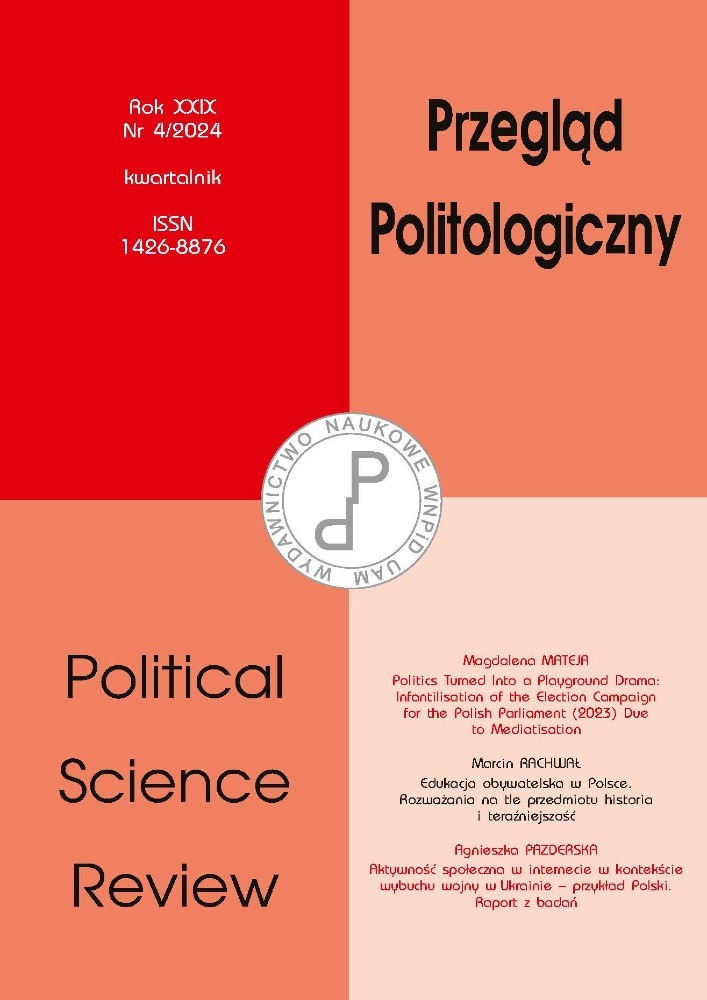Abstract
Affirmative actions, their effectiveness, impact, and validity are the subject of research undertaken by sociologists, psychologists, and political scientists. Although scholars and practitioners have been involved in these processes, affirmative actions are still controversial, and the convergence of positions and opinions on that issue is still a long way off. By referring to the origins and examples of compensatory activities, this paper attempts to assess the effectiveness and validity of positive discrimination. In particular, our attention is paid to menstrual leaves. Despite having a history of almost eighty years, they are still considered innovative solutions, the effectiveness of which is difficult to judge.
References
Anagnostopulu A. (2021), Masz okres? Przysługuje ci dodatkowy dzień wolnego. Urlop menstruacyjny wprowadziła także polska firma, BisinessInsider, https://businessinsider.com.pl/wiadomosci/urlop-menstruacyjny-w-polsce-i-na-swiecie/fgjrs9j.
Baird A., Hill E., Colussi S. (2020), Mapping menstrual leave legislation and policy historically and globally: A labor entitlement to reinforce, remedy, or revolutionize gender equality at work?, “Comparative Labour Law & Policy Journal”, nr 42(1), s. 187–225.
Barnack-TavlarisJessica L., Hansena K., Levitt R. B., Renob M. (2019), Taking leave to bleed: Perceptions and attitudes toward menstrual leave policy, “Health care for women international”, vol. 40, nr 12, s. 1355–1373. DOI: https://doi.org/10.1080/07399332.2019.1639709
Bhattacharya A., Kumar S., Pattnaik A. (2021), Menstrual leave at workplace: employees’ point of view, “Parikalpana – KIIT Journal of Management”, vol. 17, s. 36–44. DOI: https://doi.org/10.23862/kiit-parikalpana/2021/v17/i1/209016
Cooper B. (2023), The Failure of Affirmative Action, “The Atlantic”, 19 czerwca, https://www.theatlantic.com/ideas/archive/2023/06/failure-affirmative-action/674439/.
Crosby F. J. (2004), Affirmative Action Is Dead; Long Live Affirmative Action, Yale University Press, New Haven. DOI: https://doi.org/10.1037/e538492010-007
Dan A. (1986), The Law and Women’s Bodies: The Case of Menstruation Leave in Japan, “Healthcare for Women International”, vol. 7(1–2), s. 1–14. DOI: https://doi.org/10.1080/07399338609515719
Decree 12/2022/Vietnam on Administrative penalties for Labor-overseas manpower-social insurance, https://dazpro.com/decree-12-2022-vietnam-on-administrative-penalties-for-labor-overseas-manpower-social-insurance/#Article_28_Violations_against_regulations_on_female_workers_and_ensuring_gender_equality.
Eliasz K. (2021), Kontrowersje wokół pozytywnej dyskryminacji, „Studia Iuridica”, nr 89, s. 47–61, https://ruj.uj.edu.pl/xmlui/bitstream/handle/item/291946/eliasz_kontrowersje_wokol_pozytywnej_dyskryminacji_2021.pdf?sequence=1&isAllowed=y. DOI: https://doi.org/10.31338/2544-3135.si.2022-89.3
Elizondo E., Crosby F. J. (2004), Attitudes toward affirmative action as a function of the strength of ethnic identity among Latino college students, “Journal of Applied Social Psychology”, nr 34(9), s. 1773–1796. DOI: https://doi.org/10.1111/j.1559-1816.2004.tb02585.x
Employment is voluntary. Nike code leadership standard, https://communications.oregonstate.edu/sites/communications.oregonstate.edu/files/licensing/pdf/nike_inc_codeleadershipstandards_may2014.pdf.
Ewangelia wg św. Łukasza. Pismo Święte Nowego Testamentu i psalmy (2005), Edycja św. Pawła.
Crosby F. J., Iyer A., Sincharoen S. (2006), Understanding Affirmative Action, “Annual Review of Psychology”, nr 57, s. 585–611. DOI: https://doi.org/10.1146/annurev.psych.57.102904.190029
Friedan B. (2019), If Men Could Menstruate, “Women’s Reproductive Health”, vol. 6, nr 3, s. 151–152. DOI: https://doi.org/10.1080/23293691.2019.1619050
Hashimy Q. S. (2023), Exploring Menstrual Leave in Islamic Jurisprudence: Cultural and Religious Perspectives, “International Journal of Law Management & Humanities”, nr 6, Iss. 2, s. 3287–3296, https://www.researchgate.net/publication/370414888_Exploring_Menstrual_Leave_in_Islamic_Jurisprudence_Cultural_and_Religious_Perspectives.
Ilic M. (1994), Soviet Women Workers and Menstruation: A Research Note on Labour Protection in the 1920s and 1930s, “Europe-Asia Studies”, vol. 46, nr 8, Soviet and East European History, s. 1409–1415. DOI: https://doi.org/10.1080/09668139408412236
Karin M. L. (2021), Addressing Periods at Work. Addressing Periods at Work, “Harvard Law & Policy Review”, vol. 16, s. 449–518.
King S. (2021), Menstrual Leave: Good Intention, Poor Solution, https://www.researchgate.net/publication/348241120_Menstrual_Leave_Good_Intention_Poor_Solution?enrichId=rgreq-ceae65e37628c1ae06b673811e431293-XXX&enrichSource=Y292ZXJQYWdlOzM0ODI0MTEyMDtBUzoxMTQzMTI4MTIzMDE0NTk5MEAxNzEwODQyMzQ1NzUw&el=1_x_2.
Kobiety w parlamencie. Statystyki międzynarodowe, Opracowania tematyczne OT-676 (2019), Biuro analiz, dokumentacji i korespondencji, Dział analiz i opracowań tematycznych, Kancelaria Senatu, https://www.senat.gov.pl/gfx/senat/pl/senatopracowania/178/plik/ot-676_kobiety_w_polityce.pdf.
Kravitz D. A., Klineberg S. L. (2004), Predicting affirmative action attitudes: interactions of the effects of individual differences with the strength of the affirmative action plan, “Research in the Sociology of Work: Diversity in the Work Force”, vol. 14, s. 107–30. DOI: https://doi.org/10.1016/S0277-2833(04)14005-3
Kridasaksana D., Santoso B., Roisah K., Natalia A. (2020), Menstrual Leave from a Health Law Perspective in Indonesia, “The Pakistan Journal of Medical & Health Sciences”, vol. 14, nr 4, s. 1582–1594, https://pjmhsonline.com/2020/oct_dec/1592.pdf.
Kuchciak M. (2023), Analiza ISBiznes.pl: Rośnie popularność urlopów menstruacyjnych, https://isbiznes.pl/2023/12/17/rosnie-popularnosc-urlopow-menstruacyjnych/.
Labour Code of Socialist Republic of Vietnam, https://asean.org/wp-content/uploads/2016/08/Doc-9_Vietnam60.pdf.
Law on the Protection of Women’s Right and Interests of the People’s Republic of China, http://www.justice.gov/sites/default/files/eoir/legacy/2013/11/08/PeotectionofWomen’sRigkts.pdf.
Less than 10% of Female Employees Take Menstrual Leave in Japan (2022), http://www.nikkei.co.jp/nikkeiinfo/en/global_services/nikkei-bp/employee-wellbeing-management-needs-care-for-period-friendly-workplace.html.
Levitt R. B., Barnack-Tavlaris J. L. (2020), Addressing Menstruation in the Workplace, The Menstrual Leave Debate. The Palgrave Handbook of Critical. DOI: https://doi.org/10.1007/978-981-15-0614-7_43
Marzuki P. M. (2011), An Introduction to Indonesian Law. Setara Press, Fragm, https://bphn.go.id/data/documents/thehistoryofindonesianlaw.pdf.
Mouri F. L. (2024), One menstrual leave policy, “The Sun”, 7 grudnia.
Price H. H. (2022), Periodic Leave: An Analysis of Menstrual Leave as a Legal Periodic Leave: An Analysis of Menstrual Leave as a Legal Workplace Benefit, “Oklahoma Law Review”, vol. 74, nr 2, https://digitalcommons.law.ou.edu/cgi/viewcontent.cgi?article=2228&context=olr.
Reljanović M. Lj., Rajić Ćalić J. M. (2024), Menstrual Leave and Gender Equality, “Stranipravniživot”, nr 1, s. 1–14, https://www.researchgate.net/publication/379687607_MENSTRUAL_LEAVE_AND_GENDER_EQUALITY. DOI: https://doi.org/10.56461/SPZ_24101KJ
Sangren P. S. (2010), Female Gender in Chinese Religious Symbols: Kuan Yin, Ma Tsu, and the “Eternal Mother”, “Sign”, vol. 9, nr 1, http://newdoc.nccu.edu.tw/teasyllabus/113644156857/Sangren1983Guanyin.pdf. DOI: https://doi.org/10.1086/494021
Sherman D. K., Nelson L. D., Ross L. D. (2003), Naïve realism and affirmative action: Adversaries are more similar than they think, “Basic and Applied Social Psychology”, nr 25, s. 275–290. DOI: https://doi.org/10.1207/S15324834BASP2504_2
Singh P. (2022), Right To Menstrual Leave- A Shift From Period Shaming To Period Friendly Environment, “International Journal of Advances in Engineering and Management” (IJAEM), vol. 4, s. 393–395, https://www.ijaem.net/.
Sobczyk M. (2021), Problematyka nieczystości kobiety w Japonii w świetle szesnastowiecznych relacji europejskich, „Perspektywy Kultury”, nr 35, s. 105–116, https://czasopisma.ignatianum.edu.pl/pk/article/download/2046/1967/. DOI: https://doi.org/10.35765/pk.2021.3504.07
West M. S. (1998), The Historical Roots of Affirmative Actiont, “La Raza Law Journal”, vol. 10, s. 607–630. DOI: https://doi.org/10.1093/ijrl/10.4.607
Widyan D. A. (2022), Menstrual Leave Policy; Between Gender Sensitivity and Discrimination Against Female Workers, “Technium Business and Management), vol. 2, nr 2, s. 50–60. DOI: https://doi.org/10.47577/business.v2i2.6754
Worley W. (2017), The country where all women get a day off because of their period, “Independent”, 4 stycznia, https://www.independent.co.uk/news/world/africa/zambia-period-day-off-women-menstruation-law-gender-womens-rights-a7509061.html.
Zapart J. (2013), Buddyzm krytyczny w wymiarze społecznym, filozoficznym i metodologicznym (II), „The Polish Journal of the Arts and Culture”, nr 6, s. 177–193.
License
Copyright (c) 2024 Natalia Klejdysz

This work is licensed under a Creative Commons Attribution-ShareAlike 4.0 International License.

